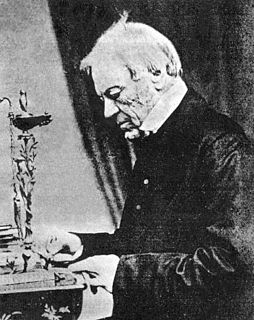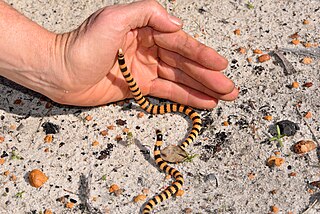
Sir John Richardson FRS FRSE was a Scottish naval surgeon, naturalist and arctic explorer.

The New Guinea mangroves is a mangrove ecoregion that covers extensive areas of the coastline New Guinea, the large island in the western Pacific Ocean north of Australia.
Myron is a genus of snakes in the family Homalopsidae. They are commonly known as 'mangrove snakes'.

Sphaerodactylus richardsonii, also known commonly as Richardson's least gecko or the northern Jamaica banded sphaero, is a small species of lizard in the family Sphaerodactylidae. The species is endemic to Jamaica.

The broad-banded sand-swimmer or Richardson’s skink is a species of skink found in Australia.
Brachyurophis morrisi, also known as the Arnhem shovel-nosed snake, is a species of venomous burrowing snake that is endemic to Australia. The specific epithet morrisi honours author and naturalist Ian James Morris for his contributions to knowledge of the animals of the Northern Territory, who first collected the species in 1970.
Simoselaps anomalus, also known as the northern desert banded snake, is a species of venomous burrowing snake that is endemic to Australia.

Simoselaps bertholdi, also known as Jan's banded snake or the southern desert banded snake, is a species of venomous burrowing snake that is endemic to Australia. The specific epithet bertholdi honours German physician and naturalist Arnold Adolph Berthold.
Simoselaps littoralis, also known as the west coast banded snake or coastal burrowing snake, is a species of venomous burrowing snake that is endemic to Australia. The specific epithet littoralis (“coastal”) refers to the species’ distribution and habitat.
Suta punctata, also known as the spotted snake or little spotted snake, is a species of venomous snake that is endemic to Australia. The specific epithet punctata (“spotted”) refers to the body markings.
Cryptophis boschmai, also known as the Carpentaria snake or Carpentaria whip snake, is a species of venomous snake native to Australia and New Guinea. The specific epithet boschmai honours Dutch zoologist Hilbrand Boschma.

Cryptophis pallidiceps, also known as the western Carpentaria snake or northern small-eyed snake, is a species of venomous snake endemic to Australia. The specific epithet pallidiceps (“pale-headed”) refers to its body markings.
Drysdalia mastersii, also known as Masters' snake, is a species of venomous snake endemic to southern Australia. The specific epithet mastersii honours Australian zoologist George Masters who collected specimens for Krefft.
Myron resetari, also known as the Broome mangrove snake or Resetar's mangrove snake, is a species of venomous homalopsid snake native to the marine waters of north-western Australia. The specific epithet resetari honours herpetologist Alan Resetar of the Field Museum of Natural History.
Myron karnsi, also known as the Aru mangrove snake or Karns' mangrove snake, is a species of venomous homalopsid snake native to the Aru Islands of Indonesia. The specific epithet karnsi honours herpetologist Daryl Karns of the Field Museum of Natural History.
Aipysurus tenuis, also known as the Arafura sea snake, Mjoberg's sea snake or brown-lined sea snake, is a species of venomous snake in the family Elapidae that is native to Australia. The specific epithet tenuis (“slender”) refers to the snake’s appearance.
Anilios ammodytes, also known as the sand-diving blind snake, is a species of blind snake that is endemic to Australia. The specific epithet ammodytes (“sand-diver”) refers to the snake's habits and habitat.
Anilios longissimus, also known as the extremely long blind snake, is a species of blind snake that is endemic to Australia. The specific epithet longissimus refers to the snake's size and appearance.
Anilios nema, also known as the thread-like blind snake, is a species of blind snake that is endemic to Australia. The specific epithet nema (“thread”) refers to the snake's slender body.
Anilios torresianus, also known as the Torres Strait blind snake or north-eastern blind snake is a species of blind snake that is native to Australia and New Guinea. The specific epithet torresianus refers to the type locality.





